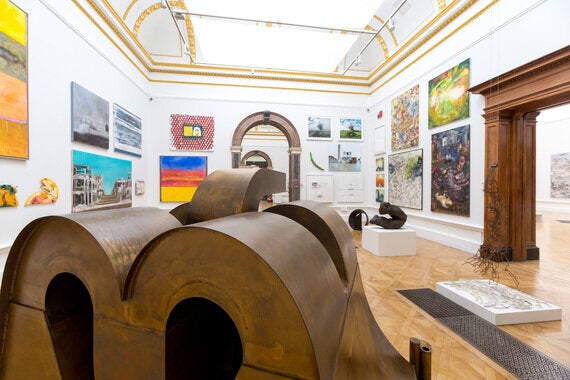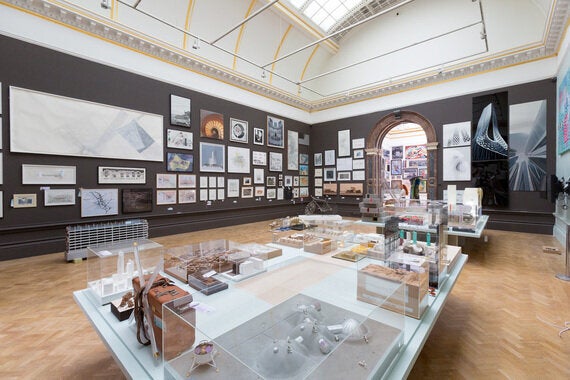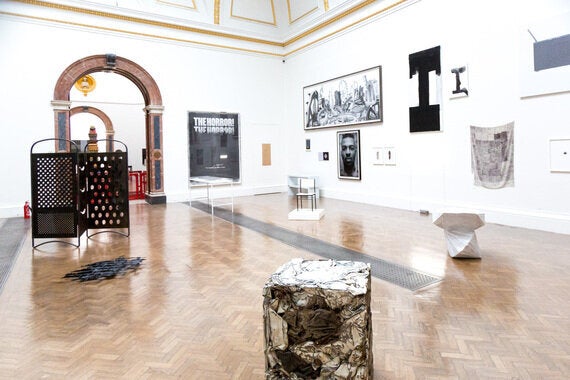
Practically a national institution, the annual Summer Exhibition at the Royal Academy of Arts is the world's largest open entry exhibition, which showcases new and recent art from emerging artists to the biggest names in contemporary art and architecture.
I've been critical of the Summer Exhibition in the past but this year's show is a revelation. Previously the galleries have felt a bit chaotic, with the quality of art on show a bit hit-and-miss, but not so this year. Evidently great care and thought has been put into the hanging and each room is full of high-quality pieces.
Each room has been hung by a single Academician with a different theme in mind. As a result, the rooms seem more coherent, making it easier to absorb the artwork.
Two rooms that are a great compare and contrast are Rooms II and the Lecture Room. The former, hung by Hughie O'Donoghue has its focus on paintings in elemental states, emphasising constituents of colour, form and material. This room is dominated by large canvases dominated with bold colours.
Whereas the Lecture Room, hung by Cornelia Parker, is themed in black and white. Cornelia Parker wanted the pieces here to investigate monochrome, as a deliberate juxtaposition to the riot of colour that is the traditional style of the Summer Exhibition. The room works perfectly as the intended visual firebreak.

Maybe it's the impact of having 15 new Royal Academicians appointed this year as this year's show is really fresh and dynamic. I can't ever remember the Architecture room embracing punk but this year the voice of John Lydon bounces off the walls as one of the works in this room is a film with soundtrack courtesy of Public Image Ltd. - Two Nuns by Ron Arad. The times, they are a changing!
Of course the great attraction, the unique aspect to the Summer Exhibition, is its democracy. Any artist can submit work to the Royal Academy for consideration and the resulting array of works that pass that test still cram the walls of many of the rooms.
There's something wonderful about being overwhelmed by the walls where there's not a spare inch to be found, every bit covered by a piece of work that has made an artist's dream come true. Only thankfully with the walls themed e.g. portraiture, it's easier for the eye to wander across the paintings and take them all in.
There are some great pieces on show. Plenty of visitors were hovering around Una Stubbs' watercolours of Benedict Cumberbatch and Martin Freeman but just above these headline-grabbers is Two People by Barbara Sykes, which won the Hugh Casson Drawing Prize.
It's a beautiful drawing. I wanted to tell all the fans looking at Stubbs' watercolours, 'look up! Look up!' But I think they were more focused on taking surreptitious snaps of the Sherlock stars with their iPhones. Shame.

Of course, being such a loved tradition, the Summer Exhibition attracts a diverse audience and I always enjoy observing which art catches people's attention.
I was pleased that so many paused in front of more abstract work such as Anselm Kiefer's Kranke Kunst. He is such an important artist and the subject of a dedicated exhibition later this year at the RA.
And many seemed quite moved by Sean Scully's Doric Night, a collection of rectangular oil on aluminium shapes in various shades of black. A very dark piece that was hung well, a great juxtaposition to the colours that surround it.
But of course not all of the art will appeal to everyone - the intention is that hopefully you will find some that speak to you - and I did hear a few comments along the lines of "I mean, where would you put that brown jobby?"
To be expected, I suppose. But there were also some interesting assumptions about the artists, such as "oh look, there's always the woman who does the liquorice allsorts" - a reference to Allsorts (Double Square) painted by, ahem, Robert Dukes.

The winner of the Charles Wollaston award this year - the award for the most distinguished work in the exhibition - went to Wolfgang Tillmans Greifbar 1. A huge inkjet print of what seemed like a red fluid flowing out into clear liquid. Some thought it was like blood in water. It is such a distinctive piece and is the dominant piece of the exhibition in that you can see it at the far end of the gallery as soon as you walk in. It is a worthy winner.
The Summer Exhibition is always popular but getting people to stay and take their time to really look at the pieces can be a bit of a challenge so credit to the RA for introducing a Pimms bar in the galleries with a smattering of tables and chairs to allow visitors to take a breather.
Sadly but inevitably I left the Exhibition without any original art to my name. I just about managed to scrape the pennies together to buy the exhibition catalogue. How I longed to take home one of the romantic Bill Jacklin paintings or the glorious Indian Festival on the Ganges by Anthony Eyton which reflected the sensory overload of this festival perfectly.
These paintings though were in the thousands but as an impoverished writer I didn't even have the pennies to buy one of the more affordable Tracey Emin sketches (her erotic Away From It All was wonderful), But at £375 these had all long gone anyway.
One day, Victoria, one day. Perhaps I'll have to settle for going one better and pick up the paints and pencils and submit one of my own masterpieces instead.
But don't hold me to that!
Royal Academy of Arts, London to August 17, 2014
Image credits: Installation views of Royal Academy Summer Exhibition 2014 © Benedict Johnson
Victoria's debut novel Banking on Burlesque is available now.